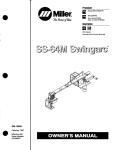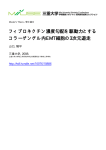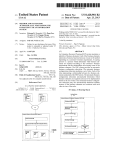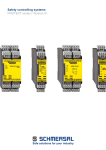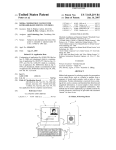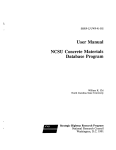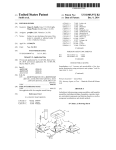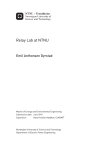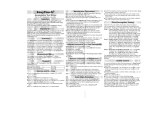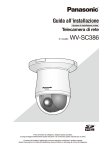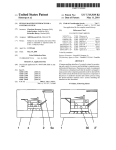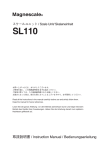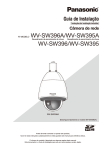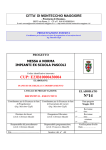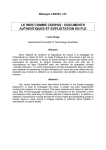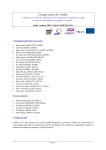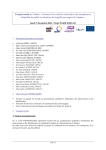Download in: “E w
Transcript
US007996245B2
(12) Ulllted States Patent
(10) Patent N0.:
Gejdos et al.
(54)
(75)
US 7,996,245 B2
(45) Date of Patent:
PATIENT_CENTRIC HE ALTHC ARE
6,322,502 B1
INFORMATION MAINTENANCE
6,425,863 B1
6,562,001 B2
11/2001 Schoenberg et a1.
7/2002 Werner et a1.
5/2003 Lebel et a1.
Inventors: I gor G e]_d os, I 11d_1anapo 1_1s, IN (Us) ;
6,564,105 B2
5/2003 .Starkweather et a1.
Schuyler Buck, Muncie, IN (US); David
(Commued)
Bradley
(US); Morris
Mill‘klSOhIl,
J. Young,
Ind1anapol1s,
Ind1anapol1s, IN
DE
20217855
20003
(US); Timothy L. Beck, Pendleton, IN
_
(Us)
(Contmued)
(73) Assignee: Roche Diagnostics Operations, Inc.,
OTHER PUBLICATIONS
Indianapolis, IN (Us)
_
_
( * ) Nonce:
_
Wang, C. et al.; “A CORBA-Based Object Framework with Patient
_
_
Identi?cation
subleqw any dlsclalmers_ the term Ofthls
Translation
Filed:
and Dynamic Linking,
Methods for
Exchanging Patient Data,” Methods of Information in Medicine,
Patent 15 extended Or adlusted under 35
Mar.
U~S~C- 15403) by 744 day5~
Verlagsgesellschaft mbH, Germany.
1999,
pp.
56-65,
(21) Appl. No.: 11/999,874
(22)
Aug. 9, 2011
vol.
38,
N0.
1,
F.K.Schattauer
(Continued)
Dec. 7, 2007
Primary Examiner * Gerald J. O’Connor
Assistant Examiner * Minnah Seoh
(65)
Prlor Pubhcatlon Data
US 2009/0150176 A1
(74) Attorney, Agent, or Firm * Baker & Daniels LLP
Jun. 11,2009
(51) Int- ClG06Q 10/00
G06Q 50/00
G06G 7/00
(52)
(2006-01)
(2006-01)
(2006-01)
G06F 17/00
(2006-01)
US. Cl. .............................................. .. 705/3; 705/2
(57)
ABSTRACT
A system for facilitating patient centric healthcare informa
tion maintenance. For example, a health management soft
Ware system may be operated to receive, organize, and use
patient medical information. The health management soft
Ware may comprise a database for storing, retrieving, orga
niZing, displaying, and, generally, for managing a patient’s
(58)
Field of Classi?cation Search ................. .. 705/2i3
health. In One exemplary embodiment, the health manage
See application ?le for complete Search history,
ment software system is used in conjunction With ahealthcare
(56)
maintenance device, such as a blood glucose monitoring sys
tem. The blood glucose monitoring system may contain sev
eral database objects in the form of data records. Typically in
a portable blood glucose monitor, each data record contains a
References Cited
U.S. PATENT DOCUMENTS
5,251,126 A
10/1993 Kahn et a1,
5,497,486 A
3/1996 Stolfo et a1.
2
5’95l’300 A
5:995:962 A
I151?“ et
time and a concentration data element, or a time-amount
point. Similarly, aninsulin pump, Whichis another exemplary
l
embodiment of a healthcare maintenance device, may main
9/1999 13103;? e a '
tain data records With time and dosage information, or a
11/1999 Horowitz
6,024,699 A
2/2000 SurWit et a1.
6,032,119 A
2/2000 Brown et a1.
time-dosage Point
24 Claims, 11 Drawing Sheets
?aw-mm‘
Egg]
ACCU-CHEK'360‘
@wwnm
°"""""""L§|Ei?i@|@|l§||%lml?l
lllllelllllAndomn 01/21/1060 0:361
@
z‘
Emmy
E M
M“ ""
M
>
E
m- omma-m
EH1
P“
m, b '1'?‘ m§g=aar“FM”‘l'l-"ldi‘é'i??f‘mwmn'?
> _
Wr??mmwii?? m '-
E
mam
Emmi“ 1» _
“'“Z?i?w
lnllll
_M
WWW»
4H
5
4m
in:
'
“E
w
15.
mg
2.50
I
25.01%
L
m
g“ lll?lmywmhlllbll?m
151
111D
4155
mum
mun-Mum‘
US 7,996,245 B2
Page 2
U.S. PATENT DOCUMENTS
6,571,128
6,577,899
6,585,644
6,605,038
6,635,014
6,648,821
6,659,948
6,668,196
6,684,191
6,687,546
6,694,191
6,733,446
6,740,075
6,748,402
6,758,810
6,781,522
6,804,656
6,810,290
6,811,533
6,811,534
6,813,519
6,852,104
6,873,268
6,873,807
6,958,705
6,990,434
7,020,508
7,024,236
7,029,455
7,041,468
7,050,735
7,063,665
7,082,334
7,113,946
7,120,488
7,165,062
7,179,226
7,181,350
7,207,009
2002/0016568
2002/0029776
2002/0040208
2002/0059299
2002/0140976
2002/0193679
2003/0002848
2003/0011646
2003/0065308
2003/0065536
2003/0069758
2003/0098869
2003/0140044
2003/0145206
2003/0163088
2003/0199739
2003/0208465
2004/0030987
2004/00383 89
2004/0073464
2004/0086314
2004/0111296
2004/0119742
2004/0172284
2005/ 0004947
2005/0010452
2005/0137653
2005/0159977
2005/0182655
2005/0187794
2005/0192844
2005/0259945
2006/0010014
2006/0020491
2006/0031094
2006/0095298
2006/0155581
2006/0161460
2006/0167367
B2
B2
B2
B1
B2
B2
B2
B1
B1
B2
B2
B2
B2
B1
B2
B2
B1
B2
B2
B2
B2
B2
B2
B2
B2
B2
B2
B2
B2
B2
B2
B2
B2
B2
B2
B2
B2
B2
B1
A1
A1
A1
A1
A1
A1
A1
A1
A1
A1
A1
A1
A1
A1
A1
A1
A1
A1
A1
A1
A1
A1
A1
A1
A1
A1
A1
A1
A1
A1
A1
A1
A1
A1
A1
A1
A1
A1
A1
5/2003
6/2003
7/2003
8/2003
10/2003
11/2003
12/2003
12/2003
1/2004
2/2004
2/2004
5/2004
5/2004
6/2004
7/2004
8/2004
10/2004
10/2004
11/2004
11/2004
11/2004
2/2005
3/2005
3/2005
10/2005
1/2006
3/2006
4/2006
4/2006
5/2006
5/2006
6/2006
7/2006
9/2006
10/2006
1/2007
2/2007
2/2007
4/2007
2/2002
3/2002
4/2002
5/2002
10/2002
12/2002
1/2003
1/2003
4/2003
4/2003
4/2003
5/2003
7/2003
7/2003
8/2003
10/2003
11/2003
2/2004
2/2004
4/2004
5/2004
6/2004
6/2004
9/2004
1/2005
1/2005
6/2005
7/2005
8/2005
8/2005
9/2005
11/2005
1/2006
1/2006
2/2006
5/2006
7/2006
7/2006
7/2006
Lebel et al.
Lebel et al.
Lebel et al.
Teller et al.
Starkweather et al.
Lebel et al.
Lebel et al.
Villegas et al.
Barnard et al.
Lebel et al.
Starkweather et al.
Lebel et al.
Lebel et al.
Reeves
Lebel et al.
Sleva et al.
Rosenfeld et al.
Lebel et al.
Lebel et al.
Bowman, IV et al.
Lebel et al.
Blomquist
Lebel et al.
Umetsu
Lebel et al.
Minogue et al.
Stivoric et al.
Ford et al.
Flaherty
Drucker et al.
BardolatZy et al.
Hasegawa et al.
Boute et al.
Cosic
Nova et al.
O’Rourke
Crothall et al.
Oberding et al.
Aamodt et al.
Lebel et al.
Blomquist
Flaherty et al.
Spaey
2006/0178910
2006/0184524
2006/0224638
2006/0272652
2007/0033074
2007/0048691
2007/0055940
2007/0088525
2007/0089071
2007/0179352
2007/0179975
2007/0185390
2007/0189590
A1
A1
A1
A1
A1
A1
A1
A1
A1
A1
A1
A1
A1
2007/0219432 A1
2007/0232866 A1
2007/0276197 A1
8/2006
8/2006
10/2006
12/2006
2/2007
3/2007
3/2007
4/2007
4/2007
8/2007
8/2007
8/2007
8/2007
Eisenberger et al.
PollanZ
Wald et al.
Stocker et al.
NitZan et al.
Brown
Moore et al.
Fotiades et al.
Zinn et al.
Randlov et al.
Teh et al.
Perkins et al.
Fidrich et al.
9/2007 Thompson
10/2007 Nephin et al.
11/2007 Harmon
FOREIGN PATENT DOCUMENTS
EP
EP
EP
EP
EP
EP
JP
JP
JP
JP
WO
WO
WO
WO
WO
WO
WO
WO
WO
WO
WO
WO
WO
WO
0970655
0649316
1194864
1416417
1647929
1662417
04/145774
04/145775
04/145776
07/058685
WO9609590
WO0018449
WO0065522
WO0072181
WO0174229
WO0200111
WO0278512
WO03015838
WO2005037095
WO2005096206
WO2006050485
WO2007005530
WO2007084502
WO2007093482
1/2000
12/2000
4/2002
5/2004
4/2006
5/2006
5/2004
5/2004
5/2004
3/2007
3/1996
4/2000
11/2000
11/2000
10/2001
1/2002
10/2002
2/2003
4/2005
10/2005
5/2006
1/2007
7/2007
8/2007
Borg et al.
Malave et al.
Kawaoka et al.
Levine et al.
Lebel et al.
Hansen et al.
Anderson et al.
Arnold et al.
Mok et al.
WolosewicZ et al.
Blomquist
Gordon et al.
Yurko et al.
Manelli
Maus et al.
Huang
Chen et al.
Rosenfeld et al.
Silbey et al.
Sullivan et al.
Emlet et al.
Lusen
Friedman et al.
Green et al.
MerZlak et al.
Kimak
............................ .. 705/3
OTHER PUBLICATIONS
Bilenko, M. et al.; “Adaptive Name Matching in Information Inte
gration,” IEEE Intelligent Systems; Sep. 2003, vol. 18, No. 5; p.
16-23, IEEE Computer Society.
Frenger, Paul; “GRANNIE 2.‘ a Ubiguitious, Protean Robotic Guard
ian Angel,” Automation Science and Engineering, Sep. 1, 2007, pp.
857-862, IEEE International Conference on IEEE.
Frenger, Paul; “GRANNIE: A Scalable, Interactive, Arti?cial Intelli
gence Supervisory Systemfor Medical Devices,” Proceedings of Can.
Med. Bio. Engr. Conference, 2007, p. 256-259.
“CoPilot Health Management System Version 3.1,” User’s Guide,
Mar. 2007, 230 pp., ART 10641 Rev. D, Abbott Diabetes Care, Inc.
“MediSense® Precision Link® Diabetes Data Management Soft
ware,” User’s Guide, May 2006, 58 pp., 116-412 Rev. AC, Abbott
Diabetes Care, Inc.
Albisser, Michael A.; “A Graphical User Interface for Diabetes Man
agement Than Integrates Glucose Prediction and Decision Support,”
Diabetes Technology & Therapeutics, 2005, pp. 264-273, vol. 7, No.
2.
Janssen et al., “Acensia® Winglucofacts® Professional Intelligent
Esler et al.
Diabetes Management Software Is An Effective Tool for the Man
Splaver
agement of Diabetes,” Bayer HealthCare Clinical Summary Report,
Brown
Jul. 2005, 10 pp.
Mongeon et al.
Joshy et al.; “Diabetes Information Systems: A Rapidly Emerging
Cohen et al.
Bina
Eisenberger et al.
Smitherman et al.
StancZak et al.
Support for Diabetes Surveillance and Care,” Diabetes Technology &
Therapeutics, 2006, pp. 587-597, vol. 8, No. 5.
“OneTouch Diabetes Management Software,” User Manual, 2006,
173 pp. v. 2.3.1, Lifescan, Inc.
US 7,996,245 B2
Page 3
“Getting Started, CareLink Personal Therapy Management Software
for Diabetes,” Brochure, 2007, 20 pp., Medtronic Minimed, Inc.
“Accu-Chek® Camit Pro Diabetes Management Software,” User’s
Manual, 2005, 220 pp., v2.1 and Addendum v. 2.4, Roche Diagnos
tics Corp.
“Accu-Chek® Compass Diabetes Care Software,” User’s Guide,
2005, 74 pp., Roche Diagnostics Corp.
“Accu-Chek® Diabetes Assistant,” accessed with notional data and
printed from www.diabetesassistant.com on Jan. 16, 2007,20 pp.,
Roche Diagnostics Corp.
PCT International Search Report and Written Opinion of the Inter
national Search Authority for Pat. Appl. No. PCT/EP2008/009857.
* cited by examiner
US. Patent
Aug. 9, 2011
Sheet 1 0f 11
US 7,996,245 B2
12
\
111
18
b >>>>
/
2 A/ $0 FTWARE
8
\
PATIENT
STATISTICS
DATA
TIME-AMOU NT
FIG. 1
US. Patent
Aug. 9, 2011
Sheet 2 0f 11
US 7,996,245 B2
10
/12
19
18
15
lLnmr'w
FIG. 2
<Addltlonal_lnstr>
vI Date and 11ma
I lnformatlon
| Error
;
4/26/2006 9:04 am D6: 85 mgldL
®
1...
bG: 105 mgldL
Missing date and time
El
4/25/200611254 pm D6: 94 mg/dL
4/25/2006 9:10 am bG: 115 mgIdL
A 4/16/2006 1:28 pm bG: 80 mg/dL
4/16/2006 5215 pm bG: 75 mgIdL
[
uELErE ;][
Out of sequence
AOCEPTASIS
IEREASSIGN {Foe/renames]
E
F OK
FIG. 3
[I cANcELJ
US. Patent
Aug. 9, 2011
Sheet 4 0f 11
6:2mm053:.
v6
m:
v5
3.“
v6
M
:2NS5
1
mg
5 .m6w @M\29Ea;:
:
m2uz5om
US 7,996,245 B2
WE
.2:v
/
,
52:8;
zmoHaG-gEw 0N2E5%;
A
7
w:
v6
US. Patent
Aug. 9, 2011
Sheet 6 0f 11
US 7,996,245 B2
El]
Accu-cHEKo 360° Data Mlgratlon Utility
L Data Mlgration - Select Source Database Type
M»)
Select the type of database to be migrated toACCU-CHEK 360°
6)
O ACCU-CH EK Compass
O ACCU-CH EK 360°
Click ‘Next’ to continue.
FIG. 6
ACCU-GHEKQ 360' um Migration Utility
[Z]
Help)
L Data Migration - Select Source
Select the database to be migrated.
Source
Description
Pam
ACCU-CHEK 3 AOw-Chek 380° FWLT-LONERZ‘AOOUCHEIQGUMOCUCHELJ
ACCU-CHEK 3 Aoou-Chek 360° HVLTCHWCUCHEKZ
IE!
Click "Next' to oon?nuo.
FIG. 7
US. Patent
Aug. 9, 2011
Sheet 7 0f 11
US 7,996,245 B2
l2]
ACCU-CHEKO 360’ Data Migration Utlllty
Help J
k Data Mlgra?on - Select Destination
Select the destination database for the migration.
Source
Description
AOCU-CHEK 3 Aaou-Chek 360°
I
Browse
Path
Fwmomeapowcugesmooucrgy
Comments v
Omrent D
Mlgrat"
Create New
Click “Nemt' to continue.
FIG. 8
ACCU-CHEK® 360" Data Migration Utility
L Data Migration - Check Databases
A
Help)
Wamingl Make sure that the source and destination databases are not in
use rlorto startin the mi ration. The data may be migrated Incorrectly if
the atabases are n use uring the migration.
Click ‘Next’ to continue.
FIG. 9
US. Patent
Aug. 9, 2011
Sheet 8 0f 11
US 7,996,245 B2
ACCU-CHEKQ 360° Data Migration Utility
[X]
LData Migration - Options
Help J
The following screens will guide you through selecting the data to migrate.
El Do not display this screen egein.
Oiick “Next” to continue.
F I G . l0
AOCU-CHEKQ 860” Data Migration Utility
[2]
L Data Migration - Patient Options
Heb J
Select ?le migration options below:
Patient Date
Select ihe date range fol-the patient data 00 be migrated.
Range: |_Al| Data
Pa?ent Data includes bG results,
heulln, carbs. e00.
iv] |01I0fli800 -12I31I2200|E
Pa?ent Information
6) Keep Existing Data
Petiiienésinforrnaiioéidineiudes the
gg'ggg'gghmgm
mum-egg "m
Patienl Settings
gmwmm
OMefgeDaia g
P°"§i‘i§°‘“"%%5i'%%€°bi'$2"£é’€i
0v rwriie Exis?n Data
Ciiok ‘Next’ to continue.
‘:5 "=
m°nt°m
I
FIG. 11
US. Patent
Aug. 9, 2011
Sheet 9 0f 11
US 7,996,245 B2
ACCU-CHEKO 360° Data Migration Utility
@
L Data Migration - Physician Options
Help)
Salad the migration options below:
Healihcam Provider Data
(9 Keep Exls?ng Data
oovarwiite Existing Data
0 Merge Data
Haalihcara Provider Data includes
name. address. fax number. oh:
Click ‘Next’ to continue.
F I G . l2
ACCU-CHEKO 360' Data Migration Utility
L Data Migration - Migrating Data
Help
Migrating data from
FwLT-Lommmccuciimuccum-EKJ
to
mnoAumztAocuci-ici-l?u
0 MO min-49sec
@L
I
| FIG.
"MK 13
II
"Em
US. Patent
Aug. 9, 2011
Sheet 10 0f 11
US 7,996,245 B2
ACCU-CHEKO 360' Data Migration Utility
@
L Data Migration - Posslbie Duplicate Patient
Hglp J
The following patients may be the same person. Setea how to proceed.
Pending Patient:
Name: Bob Jones
Date of Birth: 01/01/1970
ID:
Existing patient in ACCU-Cl-IEK 360°:
Name: Robert Jones
Date of Birth: 01I01I1970
ID:
How do you went to proceed with this pending patient?
(9 Create as a new patient
0 Merge with a different patient
0 Merge with this existing patient
0 Sidp title pending patient (NOTE: patient will not be migratedl)
El From now on, etwaye create new patients (do not display this screen again)
FIG. lli
AOCU-CHEKo 360*‘ Data Migration Utility
[2]
LData Migration - Duplicate ID
The pond!
Help)
patient'e ID matches the iD of an existing patient in AOCU-CHEK 380° and muet be
changed pnorto importing the patient.
Pending Patient:
ExistlngLpa?ant In AOClJ-CHEK 360°:
Name: Mark Johnson
Name: Fred lleyen
Date of Birth: 02/02/1972
ID: 0123456789
Date of Birth: 06/08/1964
ID: 0123466789
Entera ditferent ID for Mark Johnson
'1' Required Field
FIG. 15
US. Patent
Aug. 9, 2011
Sheet 11 0f 11
US 7,996,245 B2
Accu-cHEKe 3130’ Data Migration Utility
E]
L Data Migration - Possible Duplicate Heaithcare Provider
Harp)
‘iiie foiiowing heaiihcare providers may be the same person. Select how to proceed.
Name: Tom Je?’ery
Existing Heaithcare Provider in ACCU-CI-IEK 380°:
Name: Thomas Jeffrey
Speciality:
Speoiaitiy:
Pending Heaithcare Provider:
How do you want to proceed with this pending heaitheare provider?
@[Creaie as a new heaithcare grovideri
0 Merge with a different heaiiircare provider
0 Merge with this existing heaiihcare provider
OSkip this pending heeithcere provider (NOTE: heaiihcare provider will not be migratedl)
D From nowon, always create new heaiiheare providers (do not display this screen again)
FI G . 16
ACCU-CHEKQ 360‘ Data Migration Utility
[2]]
L Data Migration - Migration Complete
The mlgra?on fmm FWLT-LOANEMAOGJCHEIQGOWCCUCHEKJ to
HNLT-LOANER2\ACCUOHEK360\ACCUCHEK 3 Is 00 in late.
if you wwid like to migrate ano?ier database. oil-d the 'h?grate Another Database‘ link.
Migration Summary:
Summary:
:_
New Automatic 1
New Manual: 0
Merged Automatic: 0
Merged Manual: 0
Sidpped: 1
New Patients Automatic:
Mark Johnson (DOB: 02/02/1972)
skipped Patients:
I
Bob Jones (DOB: 01/01/1970)
F I G. 17
US 7,996,245 B2
1
2
PATIENT-CENTRIC HEALTHCARE
INFORMATION MAINTENANCE
another exemplary embodiment of a healthcare maintenance
device, may maintain data records With time and dosage
information, or a time-dosage point.
To analyZe the data in a HCM device, the data may be
copied or transferred to a computer, typically by loading into
FIELD OF THE INVENTION
The present invention relates to patient centric healthcare
information maintenance.
a database. When data is transferred from an HCM device to
a computer, the HCM device often includes self-identifying
information along With the patient data. The computer may
BACKGROUND OF THE INVENTION
then create device data tables that associate the self-identify
ing information of each HCM device to a particular patient. In
one exemplary embodiment, the HCM device may include a
Many ?elds of medical treatment and healthcare require
monitoring of certain body functions. Thus, e. g., for patients
suffering from diabetes, a regular check of the blood glucose
speci?c patient identi?er With the time-amount data. While
level forms an essential part of the daily routine. The blood
glucose level has to be determined quickly and reliably sev
eral times per day. Health monitoring devices are used to
facilitate the collection of medical information Without
the computer may assume that there is a direct correspon
unduly disturbing the lifestyle of the patient. A large number
of health monitoring devices for monitoring various body
readings are made.
Therefore, each data record that is transferred from a HCM
functions are commercially available.
Nevertheless, the use of health monitoring devices involves
some risks Which are mainly due to the complexity of using
health monitoring devices. The risks are sometimes more
pronounced for elderly patients or infants. Misuse of the
health monitoring devices may lead to handling failures and
dence betWeen the HCM device, the patient, and the time
amount data, the HCM device itself may be used by different
people and may be used inappropriately such that incorrect
20
25
to insuf?cient or even inaccurate information. Further, since
many of the patients handling the health monitoring devices
have not undergone medical training, the interpretation of the
medical data collected by the health monitoring devices may
be challenging to them. Often, patients are required to see
select an undo option. When the undo option is selected by the
user, each of the transferred entries, each representing a par
ticular time-amount data point, may be selected by the user
for deletion or re-as signment. For example, if the user notices
that one of the data points has an invalid value (e. g., a missed
reading by a glucose monitor) then that particular invalid
30
their doctors in short time-intervals on a regular basis.
To reduce the frequency of necessary visits to doctors, the
idea of home care gained popularity over the recent years. The
availability of communication netWorks, such as the internet
and Wireless communication netWorks, led to the develop
ment of health management systems that enable transmission
of patient medical data from the patient’s home to a health
care center by using health monitoring devices and data trans
fer systems. U.S. Pat. No. 7,103,578 and U.S. Published
Application No. 2004/0172284 disclose tWo such methods
and systems, the disclosures of Which are incorporated by
reference.
Known health management systems have several disad
device is tagged by the health management softWare system
as a neW entry. Once the transfer is complete, the user may
35
value may be deleted by the user. In one embodiment, such a
deleted data record is erased from the database. In another
embodiment, such a deleted data record is marked as deleted
and identi?cation of the person making the deletion is
storedialloWing a subsequent revieWer to see all the deleted
records and decide if the deletion Was proper. Additionally, in
another exemplary embodiment, the user may reassign a par
ticular data point to another patient. Further, in one exemplary
embodiment, the user may also reassign the HCM device to
another patient, so that all the transferred data Would be
associated With a neW patient and all future data from that
40
particular HCM device Would be associated With the selected
neW patient.
BRIEF DESCRIPTION OF THE DRAWINGS
ties to patients and care givers. Often, systems have limited
The above-mentioned and other features and advantages of
this invention, and the manner of attaining them, Will become
analytical capabilities. Further, many health management
more apparent and the invention itself Will be better under
vantages. Some systems provide limited interaction capabili
systems do not permit collection of additional data or modi
stood by reference to the folloWing description of an embodi
?cation of data collected by the health management system. A
need remains for systems that facilitate the use and interpre
tation of patient medical data.
ment of the invention taken in conjunction With the accom
panying draWings, Wherein:
50
FIG. 1 is a schematic operation diagram of the softWare and
database systems according to an exemplary embodiment of
the present invention;
SUMMARY OF THE INVENTION
FIG. 2 is a schematic vieW of a health care management
The present invention relates to patient centric healthcare
information maintenance. For example, a health management
softWare system may be operated to receive, organiZe, anduse
patient medical information. The health management soft
Ware may comprise a database for storing, retrieving, orga
system;
55
FIG. 4 is a screenshot of an undo operation according to
another exemplary embodiment of the present invention;
niZing, displaying, and, generally, for managing a patient’s
health. In one exemplary embodiment, the health manage
ment softWare system is used in conjunction With a healthcare
maintenance (HCM) device, such as a blood glucose moni
FIG. 5A and FIG. 5B are is a ?owchart diagram vieWs of a
60
data migration process using the methodology of an exem
plary embodiment of the present invention;
FIG. 6 is a screenshot of a source database type page
toring system. The blood glucose monitoring system may
according to an exemplary embodiment of the present inven
contain several database objects in the form of data records.
Typically in a portable blood glucose monitor, each data
FIG. 3 is a screenshot of an undo operation according to an
exemplary embodiment of the present invention;
tion;
65
FIG. 7 is a screenshot of a source database selection page
record contains a time and a concentration data element, or a
according to an exemplary embodiment of the present inven
time-amount point. Similarly, an insulin pump, Which is
tion;
US 7,996,245 B2
4
3
capable of being stored, transferred, combined, compared,
FIG. 8 is a screenshot of a destination database selection
page according to an exemplary embodiment of the present
and otherWise manipulated. It proves convenient at times,
invention;
principally for reasons of common usage, to refer to these
signals as bits, values, symbols, characters, display data,
FIG. 9 is a screenshot of a check database Warning page
terms, numbers, or the like. It should be borne in mind,
hoWever, that all of these and similar terms are to be associ
according to an exemplary embodiment of the present inven
tion;
ated With the appropriate physical quantities and are merely
FIG. 10 is a screenshot of an options guide page according
to an exemplary embodiment of the present invention;
FIG. 11 is a screenshot of a patient options page according
to an exemplary embodiment of the present invention;
FIG. 12 is a screenshot of a physician options page accord
ing to an exemplary embodiment of the present invention;
used here as convenient labels applied to these quantities.
Some algorithms may use data structures for both inputting
information and producing the desired result. Data structures
greatly facilitate data management by data processing sys
tems, and are not accessible except through sophisticated
softWare systems. Data structures are not the information
FIG. 13 is a screenshot of a data migration process page
content of a memory, rather they represent speci?c electronic
structural elements Which impart a physical organiZation on
according to an exemplary embodiment of the present inven
tion;
the information stored in memory. More than mere abstrac
tion, the data structures are speci?c electrical or magnetic
structural elements in memory Which simultaneously repre
FIG. 14 is a screenshot of a duplicate patient identi?cation
dialog according to an exemplary embodiment of the present
invention;
sent complex data accurately and provide increased e?i
FIG. 15 is a screenshot of a neW medical management
system identi?cation prompt according to an exemplary
embodiment of the present invention;
20
Further, the manipulations performed are often referred to
in terms, such as comparing or adding, commonly associated
With mental operations performed by a human operator. No
FIG. 16 is a screenshot of a duplicate healthcare provider
dialog according to an exemplary embodiment of the present
invention; and
FIG. 17 is a screenshot of a data migration complete page
according to an exemplary embodiment of the present inven
tion.
25
form part of the present invention; the operations are machine
ers or other similar devices. In all cases the distinction
30
35
constructed for the required purposes or it may comprise a
general purpose computer as selectively activated or recon
40
For the purposes of promoting an understanding of the
principles of the invention, reference Will noW be made to the
embodiments illustrated in the draWings, Which are described
?gured by a computer program stored in the computer. The
algorithms presented herein are not inherently related to any
particular computer or other apparatus. In particular, various
general purpose machines may be used With programs Written
in accordance With the teachings herein, or it may prove more
45
convenient to construct more specialiZed apparatus to per
50
form the required method steps. The required structure for a
variety of these machines Will appear from the description
beloW.
The present invention deals With “object-oriented” soft
Ware, and particularly With an “object-oriented” operating
be exhaustive or limit the invention to the precise form dis
closed in the folloWing detailed description. Rather, the
embodiments are chosen and described so that others skilled
in the art may utiliZe their teachings. It Will be understood that
no limitation of the scope of the invention is thereby intended.
The invention includes any alterations and further modi?ca
tions in the illustrated devices and described methods and
mechanical, chemical) physical signals to generate other
desired physical signals.
forming these operations. This apparatus may be speci?cally
any manner.
beloW. The embodiments disclosed beloW are not intended to
betWeen the method operations in operating a computer and
the method of computation itself should be recogniZed. The
present invention relates to a method and apparatus for oper
ating a computer in processing electrical or other (e. g.,
The present invention also relates to an apparatus for per
not to be construed as limiting the scope of the invention in
DETAILED DESCRIPTION OF EMBODIMENTS
OF THE INVENTION
such capability of a human operator is necessary, or desirable
in most cases, in any of the operations described herein Which
operations. Useful machines for performing the operations of
the present invention include general purpose digital comput
Corresponding reference characters indicate correspond
ing parts throughout the several vieWs. Although the draWings
represent embodiments of various features and components
according to the present invention, the draWings are not nec
essarily to scale and certain features may be exaggerated in
order to better illustrate and explain the present invention.
The exempli?cations set out herein illustrate preferred
embodiments of the invention and such exempli?cations are
ciency in computer operation.
system. The “obj ect-oriented” softWare is organiZed into
“objects,” each comprising a block of computer instructions
further applications of the principles of the invention Which
describing various procedures (“methods”) to be performed
Would normally occur to one skilled in the art to Which the
in response to “messages” sent to the object or “events” Which
invention relates.
The detailed descriptions Which folloW are presented in
55
occur With the object. Such operations include, for example,
the manipulation of variables, the activation of an object by an
part in terms of algorithms and symbolic representations of
external event, and the transmission of one or more messages
operations on data bits Within a computer memory represent
to other objects.
ing alphanumeric characters or other information. These
descriptions and representations are the means used by those
skilled in the art of data processing arts to most effectively
Both programs and databases may be objects. In the case of
60
databases, the data portion of the object may be signi?cantly
larger than the methods portion, The actual physical imple
convey the substance of their Work to others skilled in the art.
mentation of a database on a general purpose computer may
An algorithm is here, and generally, conceived to be a
self-consistent sequence of steps leading to a desired result.
take several forms, from complete individual records storing
These steps are those requiring physical manipulations of
physical quantities. Usually, though not necessarily, these
quantities take the form of electrical or magnetic signals
65
the substantive information With several key indexes for
locating a particular record, to a plurality of tables interrelated
by relational operations, to a matrix of cross-linked data
records, to various combinations and hybrids of these general
US 7,996,245 B2
5
6
types. In particular physical devices, a database may be struc
tured and arranged to accommodate the restrictions of the
physical deviceibut When transferred to a general purpose
computer be able to be stored in a variety of formats. Thus,
While certain types of information may be described as being
ZOOM FUNCTIONALITY FOR A CUSTOM REPORT;
US. patent application Ser. No. 11/999,932, METHOD AND
SYSTEM FOR SELECTIVE MERGING OF PATIENT
DATA; US. patent application Ser. No. 11/999,859,
METHOD AND SYSTEM FOR PERSONAL MEDICAL
stored in a “database” from a conceptual standpoint, gener
DATA DATABASE MERGING; US. patent application Ser.
ally such information may be electronically stored in a variety
of structures With a variety of encoding techniques.
Databases may contain many types of information, and
may store the information in a variety of encoding techniques.
No. 11/999,772, METHOD AND SYSTEM FOR WIRE
LESS DEVICE COMMUNICATION; US patent applica
tion Ser. No. 11/999,879, METHOD AND SYSTEM FOR
SETTING TIME BLOCKS; US. patent application Ser. No.
When a database stores information that relates to a particular
11/ 999,968, METHOD AND SYSTEM FOR ENHANCED
person, product, location, or other thing, the database typi
DATA TRANSFER; US. patent application Ser. No. 1 1/ 999,
cally uses a unique identi?er that binds the “concept” of the
person, product, location, or other thing With a storable piece
of data. When the unique identi?er is used to reference the
data record, the unique identi?er is termed a “key” and data
records associated With the “concept” are said to be “keyed”
by the unique identi?er. The association betWeen a key and its
data may be implemented in a variety of Ways, for example by
having the key be a ?eld in a corresponding data record, by
911, COMMON EXTENSIBLE DATA EXCHANGE FOR
MAT; US patent application Ser. No. 11/999,871,
METHOD OF CLONING SERVER INSTALLATION TO A
NETWORK CLIENT; US. patent application Ser. No.
1 1/ 999,876, METHOD AND SYSTEM FOR QUERYINGA
DATABASE; US. patent application Ser. No. 11/999,912,
METHOD AND SYSTEM FOR EVENT BASED DATA
20
having a key value in a search tree With an associated pointer
to one or more data records corresponding to the key, or by
application Ser. No. 11/999,934, SYSTEM AND METHOD
FOR REPORTING MEDICAL INFORMATION; US.
patent application Ser. No. 11/999,878, METHOD AND
encoding the corresponding information With a value that
upon decoding produces the unique identi?er and the corre
sponding data, etc. By these various methods, instances of
COMPARISON; US. patent application Ser. No. 11/999,
921, DYNAMIC COMMUNICATION STACK; US. patent
25
SYSTEM FOR MERGING EXTENSIBLE DATA INTO A
DATABASE USING GLOBALLY UNIQUE IDENTIFI
data may be associated With, or “bound” With or to, the
“concept” by using the key.
ERS; US. patent application Ser. No. 11/999,947, METHOD
area netWork,” or “WAN” mean tWo or more computers
AND SYSTEM FOR ACTIVATING FEATURES AND
FUNCTIONS OF A CONSOLIDATED SOFTWARE
Which are connected in such a manner that messages may be 30
APPLICATION; US. patent application Ser. No. 11/999,
The terms “network,” “local area netWork,” “LAN,” “Wide
transmitted betWeen the computers. In such computer net
Works, typically one or more computers operate as a “server,”
a computer With large storage devices such as hard disk drives
and communication hardWare to operate peripheral devices
such as printers or modems. Other computers, termed “Work
880, METHOD AND SYSTEM FOR CONFIGURING A
CONSOLIDATED SOFTWARE APPLICATION; US.
patent application Ser. No. 11/999,894, METHOD AND
SYSTEM FOR DATA SELECTION AND DISPLAY; US.
35
patent application Ser. No. 11/999,896, METHOD AND
stations,” provide a user interface so that users of computer
SYSTEM FOR ASSOCIATING DATABASE CONTENT
netWorks can access the netWork resources, such as shared
FOR SECURITY ENHANCEMENT; US. patent applica
data ?les, common peripheral devices, and inter-Workstation
tion Ser. No. 11/999,951, METHOD AND SYSTEM FOR
CREATING REPORTS; US. patent application Ser. No.
communication. The computers have at least one processor
for executing machine instructions, and memory for storing
40
11/999,851, METHOD AND SYSTEM FOR CREATING
instructions and other information. Many combinations of
USER-DEFINED OUTPUTS; US. patent application Ser.
processing circuitry and information storing equipment are
No. 11/999,905, DATA DRIVEN COMMUNICATION
knoWn by those of ordinary skill in these arts. A processor
may be a microprocessor, a digital signal processor (“DSP”),
a central processing unit (“CPU”), or other circuit or equiva
PROTOCOL GRAMMAR; US. patent application Ser. No.
11/999,770, HEALTHCARE MANAGEMENT SYSTEM
45
lent capable of interpreting instructions or performing logical
HAVING IMPROVED PRINTING OF DISPLAY SCREEN
INFORMATION; (US. patent application Ser. No. 11/ 999,
actions on information. Memory includes both volatile and
855), and METHOD AND SYSTEM FOR MULTI-DEVICE
non-volatile memory, including temporary and cache, in elec
tronic, magnetic, optical, printed, or other format used to
COMMUNICATION; US. patent application Ser. No.
store information. Users activate computer programs or net
Work resources to create “processes” Which include both the
11/999,866, the entire disclosures of Which are hereby
50
understood that the concepts described beloW may relate to
diabetes management softWare systems for tracking and ana
general operation of the computer program along With spe
ci?c operating characteristics determined by input variables
and its environment.
Concepts described beloW may be further explained in one
of more of the co-?led patent applications entitled HELP
UTILITY FUNCTIONALITY AND ARCHITECTURE;
lyZing health data, such as, for example, the Accu-Chek®
360° product provided by Roche Diagnostics. HoWever, the
55
US. patent application Ser. No. 11/999,906, METHODAND
SYSTEM FOR GRAPHICALLY INDICATING MUL
TIPLE DATA VALUES; US. patent application Ser. No.
11/999,853, SYSTEM AND METHOD FOR DATABASE
INTEGRITY CHECKING; US. patent application Ser. No.
11/999,856, METHOD AND SYSTEM FOR DATA
SOURCE AND MODIFICATION TRACKING; US. patent
application Ser. No. 11/999,888, EXPORT FILE FORMAT
WITH MANIFEST FOR ENHANCED DATA TRANSFER;
US. patent application Ser. No. 11/999,867, GRAPHIC
expressly incorporated herein by reference. It should be
concepts described herein may also have applicability to
apparatuses, methods, systems, and softWare in ?elds that are
unrelated to healthcare. Furthermore, it should be understood
that references in this patent application to devices, meters,
monitors, pumps, or related terms are intended to encompass
60
any currently existing or later developed apparatus that
includes some or all of the features attributed to the referred to
apparatus, including but not limited to the Accu-Chek®
65
Active, Accu-Chek® Aviva, Accu-Chek® Compact, Accu
Chek® Compact Plus, Accu-Chek® Integra, Accu-Chek®
Go, Accu-Chek® Performa, Accu-Chek® Spirit, Accu
Chek® D-Tron Plus, and Accu-Chek® Voicemate Plus, all
provided by Roche Diagnostics or divisions thereof.
US 7,996,245 B2
7
8
The present invention relates to patient centric healthcare
information maintenance. For example, the present invention
may include health management software system 2, an
embodiment of Which is shoWn in FIG. 1, Which comprises
utility creates a neW doWnload event. In one embodiment, the
user Waits While the doWnload utility receives data from HCM
device 14. In another embodiment, the user may continue to
use the glucose monitoring system 6 management softWare
While the doWnload utility receives data from HCM device 14
in the background.
one or more programs con?gured to receive, organiZe, and
use patient medical information. The health management
softWare comprises database 4 for storing, retrieving, orga
When data 8 is transferred from HCM device 14 to com
niZing, displaying, and, generally, for managing a patient’s
puter 12, HCM device 14 includes self-identifying informa
tion along With the patient data. Although the softWare is
described herein for operation on a computer (e.g., desktop,
laptop or tablet), it should be understood that the principles of
health. In this context, the term “patient” refers to a person
Whose medical information is stored in the health manage
ment softWare. Patient medical information comprises
administrative data and medical data. Patient administrative
data comprises non-medical data related to the identi?cation
the invention may be embodied in softWare for operation on
various devices, including but not limited to personal digital
assistants (“PDAs”), infusion pumps, blood glucose meters,
cellular phones, or integrated devices including a glucose
of patients (“patient identity data”) and administration of
patients and patient records (“patient non-identity data”).
Patient identity data includes name, address, phone number,
measurement engine and a PDA or cellular device. Trans
ferred data 8 may be formatted as data ?elds, or may be raW
etc. Patient non-identity data includes information pertaining
to insurance providers etc. Patient medical data, or medical
data, means qualitative and quantitative data relating to a
patient state such as, for example, test results, laboratory
values, measurements, observations, treatment or dosage val
20
HCM device to a particular patient. Thus, computer 12 uses
HCM device 14 self-identifying information to infer the
patient With Whom the time-amount data should be associ
ated. Alternatively, HCM device 14 may include a speci?c
ues, prescriptions. In addition to blood glucose values men
tioned herein, exemplary medical data may include Alc val
ues, Albumin values, Albumin excretion values, body mass
index values, blood pressure values, carbohydrate values,
cholesterol values (total, HDL, LDL, ratio) creatinine values,
fructosamine values, HbAl values, height values, insulin dose
data. Typically, transferred data 8 does not include any patient
identifying information. Rather, computer 12 has device data
tables that associate the self-identifying information of each
25
patient identi?er With the time-amount data. Typically, HCM
values. Medical data may be provided by the patient, a health
device’s self-identifying information is a key to all the data
associated With the corresponding HCM device 14. In addi
tion, the HCM device key is associated With a patient identi
?er or patient key. HoWever, While computer 12 may assume
that there is a direct correspondence betWeen HCM device 14,
patient, and the time-amount data, HCM device 14 itself may
care professional, a healthcare devise, a caregiver, or anyone
be used by different people and may be used inappropriately
having relevant data pertaining to a patient. While the inven
tion is described herein With reference to medical devices,
and more particularly, With reference to diabetes management
devices, the invention is applicable to any doWnload data
obtained from any device.
such that incorrect readings are made.
With the association betWeen the time-amount data deter
values, insulin rate values, total daily insulin values, ketone
values, microalbumin values, proteinuria values, heart rate
values, temperature values, triglyceride values, and Weight
For example, in blood glucose monitoring system 6, sev
eral database objects may be useful in organiZing the data.
Typically in a portable monitor, such as HCM device 14, each
30
35
statistics database 9 With the set or plurality of time-amount
points imported from HCM device 14 Which constitutes the
doWnload data records. Initially, patient statistics database 9
may be independent of any other data, although generally
40
such patient statistics data is desired to be combined With
previously obtained patient statistics data to provide a data
base covering several collections of time-amount points.
Typically, each patient Would have her oWn database 4 span
ning the use of HCM device 14 by that patient, and possibly
45
data from other HCM devices, or other medical or personal
data.
In addition to the plurality of time-amount data assembled
data record contains a time and a concentration data element,
or a time-amount point. Similarly, an insulin pump maintains
data records With time and dosage information, or a time
dosage point. The information in the monitor or pump may
have a particular structure, or may be serially stored With each
item of information being implicit With its location. While the
monitor or pump (collectively, “health care management
device” or “HCM device”) may have further information,
relating to the patient or other aspects of the blood, the time
and amount are the typical data points used by a physician to
and compiled from HCM device 14, computer database 4
50
evaluate the patient (“time-amount data”). The foregoing
description of embodiments of the invention relate to the
combination of time and amount data, other embodiments are
contemplated by the present invention that include time inde
pendent data, non-numerical data, and other combinations of
types of data. The computer system of the patient or doctor
55
may also include other information about a patient. This other
data may include information relating to the time-amount
data or may simply relate to the characteristics of the patient.
It is also possible that computer 12 may store other measured
readings relating to the patient (for example, heart rate or red
blood cell count) that might be useful to a physician in diag
nosing the patient. Such additional patient data may be stored
as a separate database, may be integrated into a patient data
record, or may be commingled With the time-amount data as
in a combined graph.
typically has both stored data and associated programs that
analyZe the stored data. To analyZe the data in the HCM
device, the data may be copied or transferred to the computer,
typically by loading into a database.
mined, computer 12 may then create or supplement patient
Referring to FIG. 2, system 10 may also comprise HCM
60
device 14 capable of electronic communication With com
In one embodiment, the user of HCM device 14 may start
puter 12 and con?gured to provide medical data to health
the process of doWnloading data from HCM device 14 With a
management softWare 2 (FIG. 1). In the embodiment shoWn,
doWnload utility of glucose monitoring system 6. The process
data collection cable 20 connects computer 12 to data collec
tor 16. HCM device 14 is capable of electronic communica
tion With the data collector 16. In the exemplary embodiment,
begins When the doWnload utility accesses HCM device 14,
and it ends When the utility stops doWnloading device records.
65
During a doWnload, one or more device records are doWn
health management device communicates medical data by
loaded from HCM device 14. Re-launching the doWnload
means of infrared signal 18 to data collector 16. In another
US 7,996,245 B2
9
10
embodiment (not shown), HCM device 14 has a direct con
nection to a USB port (not shown) of computer 12 and trans
mits medical data through a wired connection. In a still fur
remove download data records transferred from HCM device
14, an “UNDO” option may be used. When the UNDO option
is selected by the user, the download data records, which are
distinct from the other data records of the databases of com
puter 12, may be selected by the user for deletion. Optionally,
ther embodiment (not shown), HCM device 14 transmits
medical data over a WiFi transmission to data collector 16,
which in this embodiment is a WiFi receiver. HCM devices
the download data records may be individually selected by
are devices capable of recording information and transferring
the user for deletion or re-as signment. For example, if the user
notices that one of the data points has an invalid value (e.g., a
the information to health management software 2. HCM
device 14 may comprise a HCM device which records values
of measurements relating to a patient’s state (e.g., blood
glucose level) and information such as the time and date when
missed reading by a glucose monitor) then that particular
invalid value may be deleted by the user. In one embodiment,
such a deleted data record is erased from the database. In
another embodiment, such a deleted data record is marked as
deleted and identi?cation of the person making the deletion is
storediallowing a subsequent reviewer to see all the deleted
records and decide if the deletion was proper. Another option
the measurement was recorded. HCM device 14 may also
comprise a device con?gured to provide medications to
patients such as, for example, insulin pumps. A medication
providing device, generally, records dosage amounts as well
as the time and date when medication is provided. Optionally,
is to reassign a particular data point (e.g., when a glucose
monitor has been used on a different person) to another
HCM device 14 may have an input device, such as a keyboard,
to enable a user to provide additional manually entered data.
HCM device 14 may also comprise a computer, a PDA, or a
phone.
patient (typically done at the second computer at a physi
cian’s o?ice, but could be done at a patient’s home computer
20
ware 2. Thus, when medical data from HCM device 14 is
transferred to health management software 2, the medical
data from HCM device 14 automatically populates database
records relating to that patient. Typically, the association
if more than one patient use the computer to track health care
values). A third option involves reassigning HCM device 14
Each HCM device 14 is, generally, assigned to a patient
and associated with that patient in health management soft
25
between the patient and a particular HCM device 14 is main
tained by each HCM device 14 having a unique identi?er
(e. g., an external patient identi?er) that is bound to the patient.
to another patient, so that the download data records would be
associated with a new patient and all future data from that
particular HCM device 14 would be associated with the
selected new patient.
As shown in FIG. 3, if the “UNDO” button or menu item is
selected by a user an exemplary Undo screen appears. In the
screen, the plurality of download data records most recently
processed by system 10.
loaded from HCM device 14 is displayed with a check box or
other selection tool adjacent to the download data records, or
alternatively a check box or other selection tools is provided
for each record. In one embodiment, the menu of options is
System 10 may be used by the patient, a healthcare profes
sional, a caregiver, or anyone having relevant data pertaining
records desired and the particular operation desired, ranging
Each download of medical data from HCM device 14 thus
30
creates a new set of distinct download data records which is
to a patient. System 10 may be located in a patient’s home, a
healthcare facility, or any other convenient place. In an alter
native embodiment, two systems may be connected and
medical data may be transferred between them. For example,
a ?rst system may be located in a place accessible to the
patient or a caregiver, and a second system may be located in
a healthcare facility. In this embodiment, the ?rst and second
systems are con?gured to transfer medical data between them
by any means known in the art such as, for example, via the
listed on the screen. With this display, the user may select the
35
records to another user, or reassign HCM device 14 to another
user.
40
long as the log ?le information persists, multiple undo opera
another patient, both the data merge functionality and the
duplicate patient functionality, described in detail below, may
45
disc. The ?rst system, or patient system, may be con?gured to
receive medical data from a health management device and
the second system may be con?gured to also receive medical
data from a health management device or, alternatively, to
receive medical data transferred from the ?rst system. The
second system, or healthcare system, may be con?gured to
The tracking of new data records may be maintained by
health management software system 2 in a log ?le, so that as
tions are possible. When a user desires to reassign the data to
Internet, cellular communications, or the physical transfer of
a memory devise such as a diskette, USB key, or compact
from deleting all the selected records, to ignoring the selected
records, accept the selected records, reassign the selected
be used to select an appropriate patient to merge the health
care maintenance information.
In another exemplary embodiment, shown in FIG. 4, by
selecting the “UNDO” button or menu item, another exem
50
plary undo screen is displayed that allows the user to undo,
i.e., remove, all records from the last download of HCM
device 14 from database 4 (FIG. 1). As shown in FIG. 4, this
receive medical data from a plurality of patient systems.
The health management software is con?gured to show and
page displays a warning to the user and a summary of the last
store medical data in a plurality of forms and formats. Medi
cal data may be shown on a video display or a printed report
in record, graphic, or tabular format. The ?rst step for the
software user is to obtain medical data from the medical
device, such as an insulin pump or glucose monitor. Typically,
the user collects medical data from HCM device 14 periodi
cally, and computer 12 maintains a database of the accumu
lated medical data. Often, such medical data includes infor
number of records downloaded, and the date range for the
download, including the date, patient, device information,
55
selected, the records from the last download of HCM device
14 are removed from database 4. The download “UNDO”
function may be implemented with other download proce
60
mation covering both the dosages (e.g., when HCM device 14
is an insulin pump) and the patient measurements (e. g., when
HCM device 14 is a glucose monitor).
As medical information is transferred from HCM device
14, each device data record is included as a new entry in the
download data records. In the event that a user desires to
records downloaded. The user is then asked to indicate that
they are sure they want to undo the last download. If yes is
dures, including the download procedures disclosed in
copending US. patent application entitled METHOD AND
SYSTEM FOR ENHANCED DATA TRANSFER, the dis
closure of which is incorporated by reference.
Health management software 2 may also include a data
65
comparison program that is utiliZed to identify medical infor
mation stored in a ?rst location, i.e., a source database, that is
unique to, a duplicate of, and/or a potential duplicate of medi
US 7,996,245 B2
11
12
cal information stored in a second location, i.e., a destination
ment software once merged into destination database and
converted from source format into destination format.
database. Computer 12 may be running health management
software 2, i.e., medical management software, such as dia
In one exemplary embodiment, the medical management
software is diabetes management software. Referring to FIG.
6, a list of databases that are compatible with the diabetes
betes management software, and encrypt and save the medi
cal information transferred from HCM device 14 in one of a
source format database or a destination format database. The
management software once merged into a destination data
base is provided. Speci?cally, as shown in FIG. 6, the source
databases include, but are not limited to, databases associated
information received from HCM device 14 will be encrypted
according to an encryption feature that is speci?c to HCM
device 14. Thus, if another HCM device is used to upload
information to computer 12, it will be encrypted according to
the speci?c encryption feature of that device. As set forth
above, HCM device 14 may also assign to the patient an
external system identi?cation that may be used to correlate
the patient to a particular HCM device. As the medical infor
mation is being uploaded to computer 12 or other storage
with a glucose monitoring device or glucose monitoring soft
ware, such as those associated with ACCU-CHEK® Camit
Pro, ACCU-CHEK® Compass, and ACCU-CHEK® 360°.
As shown in FIG. 6, positioned adjacent to each source
database type displayed on the source database type page is a
corresponding button. In one exemplary embodiment, only a
single button may be selected at any given time. However, in
other exemplary embodiments, multiple buttons may be
selected for multiple, simultaneous database migration. By
media connected thereto, the data comparison utility may be
used to identify medical information stored in on HCM
selecting the button corresponding to the desired source data
device 14 that is unique thereto, a duplicate of, and/or a
potential duplicate of medical information stored on com
puter 12 or other storage media connected thereto using the
base type, a next or ?nish button may appear on the source
20
tion utility.
same or a substantially similar process as described in detail
below with speci?c reference to a data migration utility.
The data comparison program may be in the form of a
machine-readable program that is adapted to be utiliZed inde
pendent of or as an integral component of medical manage
ment software, such as diabetes management software. For
example, the data comparison program may be formed as an
Once a source database type is selected and the user has
25
object within the medical management software or, alterna
tively, may be stand alone software capable of independent
operation and installation. In one exemplary embodiment, the
data comparison program may be activated from the medical
management software after the medical management soft
descriptions of the database, the ?le path for the database, and
any comments relevant to the particular database. The source
databases may be databases that contain medical information
stored in a source format. For example, potential source data
bases may contain patient medical information that may fur
ther include numerous records associated with the individual
35
patient having data ?elds for patient identity, including title,
?rst name, middle name, last name, suf?x, and date of birth,
day and week information for the administration of medicine
and/or for test results, such as blocks of time and days of
and/ or formed as a component of a data migration utility. The
data migration utility may also be in the form of a machine
readable program that is adapted to be utiliZed independent of
or as an integral component of medical management soft
ware, such as diabetes management software. The operation
40
week, targeted event information, contact information, such
as address, phone number, and email address, emergency
contact information, such as name, relation, address, and
of the data migration utility is set forth below and includes a
phone number, demographic information, such as diabetes
diet, the diagnosis date, gender, and ethnicity, and diabetes
detailed description of the operation of the data comparison
program in the context of the data migration utility. While
described in detail herein with speci?c reference to the data
migration utility, the data comparison program may be used
also selected the next or ?nish button, the data migration
utility displays a source database selectionpage at Step 106 in
FIG. 5A. Referring to FIG. 7, an exemplary source database
selection page is shown that provides a listing of potential
source databases by type and that may include general
30
ware has been launched to compare a source database with a
destination database. In another exemplary embodiment, the
data comparison program may be utiliZed in conjunction with
database type page. By selecting the next or ?nish button, the
user may progress to the next questionnaire in the data migra
therapy, such as controlled by and date and insulin type infor
45
as a stand alone component and/or at different points during a
mation, system identi?cation, i.e., the patient’ s unique medi
cal management system identi?cation, external system iden
ti?cation, insurance, and healthcare provider data. Similarly,
data transfer process and nothing contained herein should be
the databases may include healthcare provider information
viewed as limiting the scope of the invention to this exem
that may further include numerous records associated with
plary embodiment.
50
The data migration utility is utiliZed to migrate medical
information in a source database to a destination database that
may also contain medical information. Referring to FIG. 5A,
the data migration utility is launched at Start 102 on ?owchart
100. In one exemplary embodiment, once the data migration
utility is launched, a user may be prompted for information by
dynamic questionnaires in a wiZard format. For example, the
user may be prompted to set the rules governing the migration
of data. Referring to Step 104, the user may be prompted to
select a source database stored in a source format for migra
address, phone number and email address, for example.
55
The source database selection page may also include a
browse button, shown in FIG. 7, which allows a user to
manually search the computer’s hard drive or other attached
media devices for a database location that is not listed on the
source database selection page. Referring to Step 108 in FIG.
5A, if the user selects the browse function at the source
60
tion into a destination database stored in destination format at
the source database type page shown in FIG. 6. The source
database type page allows the user to select a database type
from a list of various database types meeting the necessary
requirements for migration into the destination database. For
example, the database types listed may include only those
databases that will be compatible with the medical manage
healthcare providers having data ?elds such as healthcare
provider title, ?rst name, middle name, and last name, su?ix,
specialty, practice area, and contact information, such as
65
database selection page by selecting the browse button, Step
110 is executed and the user is prompted to select a ?le path
for the source database. In contrast, if the user does not select
the browse feature at Step 108, the user must then select one
of the databases identi?ed on the source selection page in step
106.
Irrespective of the method utiliZed to select the source
database, once the source database is selected the data migra





























